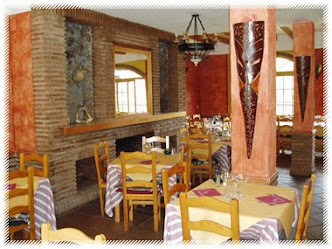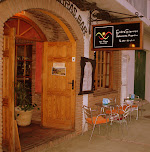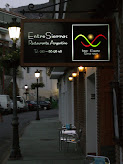Shouting "Latin Kings out!" and "We're going to get them, we're going to kill them", some 600 young people from Alcorcón met up on Avenida Alcalde José Aranda in response to the brawl between Spaniards and Latinos that left 7 hurt, three seriously injured, and another seven arrested [the latter from] the Dominican Republic, Colombia, Ecuador and Bolivia.Constantino Mendez, Madrid's security chief, says he plans to assign more police in the city to rein in Latino gangs that have turned to murder to settle scores.
An 18-year-old from the Dominican Republic died from stab wounds on Nov. 5. A 17-year-old Ecuadorian was killed in September. The deaths have raised the specter of an emerging gang-war culture in the city, said Mendez, the central government representative overseeing security in the capital.
``We want to eliminate the risk that these groups represent,'' said Mendez, 55, in an interview in Madrid on Nov. 14. ``They're causing social alarm.'' He said about 750 youths may be members of gangs inspired by groups such as Chicago's ``Latin Kings.''
A rising number of the 20,000 police in Madrid province, more than 70 percent of who are deployed in the city, will focus on curbing gang feuds, he said. Delinquency among immigrant youths is a concern because Spain relies on foreign labor to help fuel economic growth, said Octavio Una, director of sociology at Madrid's King Juan Carlos University. Spain's economy has outpaced the euro-region average of 1.7 percent for a decade.
Riots in neighboring France, where immigrants from North and West Africa and their descendents torched 9,000 cars in more than two weeks of civil unrest, should spur European countries to study how well youths from immigrant backgrounds integrate into their societies, Una said.
``Spain is concerned about this phenomenon of youth gangs,'' he said in a phone interview on Nov. 10. ``We live in an aging country that needs immigrant labor and peaceful relations.''
At 3.7 million, the non-Spanish population accounts for 8.5 percent of the country's 43.5 million inhabitants, up from 2.3 percent in 2000, according to the Madrid-based National Statistics Institute.
The unemployment rate in the third quarter was 8.2 percent for Spanish citizens, compared with 10.2 percent for foreigners, according to the government statistics office in Madrid. The jobless rate for immigrants is falling at a faster pace than for Spaniards, the institute said.
One in every six of Madrid's 3 million inhabitants is foreign born. The immigrant population has more than tripled since 2000. Ecuadorians make up the biggest part, accounting for 28 percent of ``Madrilenos'' born outside Spain, the Madrid city government's statistics show.
Latino gangs may have committed three murders this year, Manuel Moix, Madrid's chief prosecutor, said in an interview on Oct. 19.
Spain ranks eighth in Europe in terms of murder rates, below countries such as France, Germany and the United Kingdom, according to nationmaster.com, which compiles figures from sources including the United Nations Survey of Crime Trends.
Latin Americans, who make up the bulk of immigrants, have close cultural affinities with Spain, where a growing economy provides job opportunities, said Mendez.
Still, gang wars are new to Madrid and come against a backdrop of declining violent crime overall, said Moix. Murders in the city dropped to 44 in 2004 from 63 in 2003.
Mendez's strategy for tackling the gangs involves more rigorous policing of areas where members meet. Spain will expel gang members if prosecutors can prove they're violent, said Mendez, who has set up a 12-member police unit to oversee investigations into gang membership.
``Members often have problems of failure in school and lack of affection in the home,'' he said. ``That's also where we have to work.''



The Latin Kings are out there right now throwing their weight around a little bit, and we're going to make sure they feel our attention in a very special way in the next several weeks," said Chief Edward Flynn, adding that the effort will not be a sweep of Latino men, but arrests of specific gang members.
Flynn's remarks came during a 5 p.m. news conference announcing the arrests earlier in the day of two suspects, ages 17 and 21, both of whom he said had prior records. The 17-year-old was on probation for a robbery, Flynn said.
The two are expected to be charged in the robbery and killing of Lodewikus "Vic" Milford, 43, after a robbery early Saturday in Walker's Point. Milford, the director of compensation and benefits for Miller, was returning to his car with three women after they had visited a nightclub when they were robbed about 1:10 a.m. Saturday, police said. After they all gave up their wallets and purses, Milford was shot inside his SUV in a parking lot near S. 2nd and W. Walker streets.
Flynn credited the department's homicide and gang units and District 2 police officers for arresting the suspects just a few days after the crime. He also said Miller's $10,000 reward was a "significant factor" in helping detectives break the case.
Milford's killing was tragic, but the circumstances surrounding the crime are also rare in Milwaukee, Flynn said. Some 80% of the homicides in the city in 2007 involved a victim who had a criminal record, he said.
Flynn said he understands that the slaying had a profound impact on the Walker's Point area, but he believes the neighborhood is safe.
"My message to them is that justice will be done in this case. Don't lose heart, and don't lose faith," Flynn said.
Flynn said both suspects were arrested around 12:30 p.m. Wednesday. At least one of them was arrested after officers surrounded Jo Jo's tavern and an upstairs apartment at S. 6th and W. Maple streets.
A relative of the 21-year-old suspect said police were at his home Tuesday night asking about his whereabouts, what he was wearing and searching for evidence. The relative said she had not seen the man since Sunday, and that he had not seemed particularly agitated or said anything about the slaying.
The relative said the man is on an electronic-monitoring bracelet. Court records show that he was convicted of a felony drug charge in 2006 and received a stayed prison sentence of three years. One of the conditions of his probation was to not possess any firearms, according to records.
Miller Brewing Co. spokesman Julian Green said a memorial service is being planned for Milford's family, friends and co-workers at 1 p.m. Friday.
Federal prosecutors have indicted large numbers of Latin Kings several times over the past two decades for drug peddling and homicides, including 49 people in a 2005 case. A 2007 U.S. Justice Department drug trafficking intelligence report indicated that other members keep stepping up to take positions of authority in the gang.
Two Latin Kings members were charged in November in the shooting of two police officers near S. 15th St. and W. Greenfield Ave. during a shootout that wounded five people.
Flynn said police will keep up the pressure on the gang. "Their behavior has been intolerable, and we have a responsibility to our citizens to stop them," he said.
"Let's send a message here," said Mayor Tom Barrett. "If you commit a crime in this city, if you disrupt our neighborhoods, terrorize our residents or businesses, or create fear in our streets, we're coming after you, we will find you and hold you responsible."
An 18-year-old from the Dominican Republic died from stab wounds on Nov. 5. A 17-year-old Ecuadorian was killed in September. The deaths have raised the specter of an emerging gang-war culture in the city, said Mendez, the central government representative overseeing security in the capital.
``We want to eliminate the risk that these groups represent,'' said Mendez, 55, in an interview in Madrid on Nov. 14. ``They're causing social alarm.'' He said about 750 youths may be members of gangs inspired by groups such as Chicago's ``Latin Kings.''
A rising number of the 20,000 police in Madrid province, more than 70 percent of who are deployed in the city, will focus on curbing gang feuds, he said. Delinquency among immigrant youths is a concern because Spain relies on foreign labor to help fuel economic growth, said Octavio Una, director of sociology at Madrid's King Juan Carlos University. Spain's economy has outpaced the euro-region average of 1.7 percent for a decade.
Riots in neighboring France, where immigrants from North and West Africa and their descendents torched 9,000 cars in more than two weeks of civil unrest, should spur European countries to study how well youths from immigrant backgrounds integrate into their societies, Una said.
``Spain is concerned about this phenomenon of youth gangs,'' he said in a phone interview on Nov. 10. ``We live in an aging country that needs immigrant labor and peaceful relations.''
At 3.7 million, the non-Spanish population accounts for 8.5 percent of the country's 43.5 million inhabitants, up from 2.3 percent in 2000, according to the Madrid-based National Statistics Institute.
The unemployment rate in the third quarter was 8.2 percent for Spanish citizens, compared with 10.2 percent for foreigners, according to the government statistics office in Madrid. The jobless rate for immigrants is falling at a faster pace than for Spaniards, the institute said.
One in every six of Madrid's 3 million inhabitants is foreign born. The immigrant population has more than tripled since 2000. Ecuadorians make up the biggest part, accounting for 28 percent of ``Madrilenos'' born outside Spain, the Madrid city government's statistics show.
Latino gangs may have committed three murders this year, Manuel Moix, Madrid's chief prosecutor, said in an interview on Oct. 19.
Spain ranks eighth in Europe in terms of murder rates, below countries such as France, Germany and the United Kingdom, according to nationmaster.com, which compiles figures from sources including the United Nations Survey of Crime Trends.
Latin Americans, who make up the bulk of immigrants, have close cultural affinities with Spain, where a growing economy provides job opportunities, said Mendez.
Still, gang wars are new to Madrid and come against a backdrop of declining violent crime overall, said Moix. Murders in the city dropped to 44 in 2004 from 63 in 2003.
Mendez's strategy for tackling the gangs involves more rigorous policing of areas where members meet. Spain will expel gang members if prosecutors can prove they're violent, said Mendez, who has set up a 12-member police unit to oversee investigations into gang membership.
``Members often have problems of failure in school and lack of affection in the home,'' he said. ``That's also where we have to work.''



The Latin Kings are out there right now throwing their weight around a little bit, and we're going to make sure they feel our attention in a very special way in the next several weeks," said Chief Edward Flynn, adding that the effort will not be a sweep of Latino men, but arrests of specific gang members.
Flynn's remarks came during a 5 p.m. news conference announcing the arrests earlier in the day of two suspects, ages 17 and 21, both of whom he said had prior records. The 17-year-old was on probation for a robbery, Flynn said.
The two are expected to be charged in the robbery and killing of Lodewikus "Vic" Milford, 43, after a robbery early Saturday in Walker's Point. Milford, the director of compensation and benefits for Miller, was returning to his car with three women after they had visited a nightclub when they were robbed about 1:10 a.m. Saturday, police said. After they all gave up their wallets and purses, Milford was shot inside his SUV in a parking lot near S. 2nd and W. Walker streets.
Flynn credited the department's homicide and gang units and District 2 police officers for arresting the suspects just a few days after the crime. He also said Miller's $10,000 reward was a "significant factor" in helping detectives break the case.
Milford's killing was tragic, but the circumstances surrounding the crime are also rare in Milwaukee, Flynn said. Some 80% of the homicides in the city in 2007 involved a victim who had a criminal record, he said.
Flynn said he understands that the slaying had a profound impact on the Walker's Point area, but he believes the neighborhood is safe.
"My message to them is that justice will be done in this case. Don't lose heart, and don't lose faith," Flynn said.
Flynn said both suspects were arrested around 12:30 p.m. Wednesday. At least one of them was arrested after officers surrounded Jo Jo's tavern and an upstairs apartment at S. 6th and W. Maple streets.
A relative of the 21-year-old suspect said police were at his home Tuesday night asking about his whereabouts, what he was wearing and searching for evidence. The relative said she had not seen the man since Sunday, and that he had not seemed particularly agitated or said anything about the slaying.
The relative said the man is on an electronic-monitoring bracelet. Court records show that he was convicted of a felony drug charge in 2006 and received a stayed prison sentence of three years. One of the conditions of his probation was to not possess any firearms, according to records.
Miller Brewing Co. spokesman Julian Green said a memorial service is being planned for Milford's family, friends and co-workers at 1 p.m. Friday.
Federal prosecutors have indicted large numbers of Latin Kings several times over the past two decades for drug peddling and homicides, including 49 people in a 2005 case. A 2007 U.S. Justice Department drug trafficking intelligence report indicated that other members keep stepping up to take positions of authority in the gang.
Two Latin Kings members were charged in November in the shooting of two police officers near S. 15th St. and W. Greenfield Ave. during a shootout that wounded five people.
Flynn said police will keep up the pressure on the gang. "Their behavior has been intolerable, and we have a responsibility to our citizens to stop them," he said.
"Let's send a message here," said Mayor Tom Barrett. "If you commit a crime in this city, if you disrupt our neighborhoods, terrorize our residents or businesses, or create fear in our streets, we're coming after you, we will find you and hold you responsible."



















